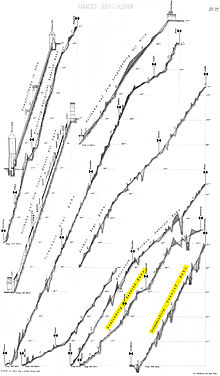Schwabenbergbahn
|
Schwabenbergbahn Városmajor – Széchenyi-hegy, Gyermekvasút |
|||||||||||||||||||||||||||||||||||||||||||||||||||||||||||||||||||||||||
|---|---|---|---|---|---|---|---|---|---|---|---|---|---|---|---|---|---|---|---|---|---|---|---|---|---|---|---|---|---|---|---|---|---|---|---|---|---|---|---|---|---|---|---|---|---|---|---|---|---|---|---|---|---|---|---|---|---|---|---|---|---|---|---|---|---|---|---|---|---|---|---|---|---|
| Route data | |||||||||||||||||||||||||||||||||||||||||||||||||||||||||||||||||||||||||
|
Schwabenbergbahn train at the entrance to the mountain station
| |||||||||||||||||||||||||||||||||||||||||||||||||||||||||||||||||||||||||
|
Route of the Fogaskerekű Vasút (orange)
| |||||||||||||||||||||||||||||||||||||||||||||||||||||||||||||||||||||||||
| Course book range : | 260 | ||||||||||||||||||||||||||||||||||||||||||||||||||||||||||||||||||||||||
| Route length: | 3.7 km | ||||||||||||||||||||||||||||||||||||||||||||||||||||||||||||||||||||||||
| Gauge : | 1435 mm ( standard gauge ) | ||||||||||||||||||||||||||||||||||||||||||||||||||||||||||||||||||||||||
| Power system : | 1500 V = | ||||||||||||||||||||||||||||||||||||||||||||||||||||||||||||||||||||||||
| Maximum slope : | 110 ‰ | ||||||||||||||||||||||||||||||||||||||||||||||||||||||||||||||||||||||||
| Minimum radius : | 90 m | ||||||||||||||||||||||||||||||||||||||||||||||||||||||||||||||||||||||||
| Rack system : | Strub | ||||||||||||||||||||||||||||||||||||||||||||||||||||||||||||||||||||||||
| Top speed: | uphill 30 km / h downhill 25 km / h |
||||||||||||||||||||||||||||||||||||||||||||||||||||||||||||||||||||||||
|
|||||||||||||||||||||||||||||||||||||||||||||||||||||||||||||||||||||||||
The Schwabenbergbahn ( ung. Fogaskerekű Vasút ) is a single-track, standard-gauge rack railway in Budapest , the capital of Hungary . It leads from the central Városmajor ( Stadt-Meierhof ), near the Széll Kálmán tér (1951–2011 Moszkva tér ) and the south station ( Déli pályaudvar ), to the 420-meter-high Swabian mountain ( Svábhegy ), with the final station Széchenyi hegy . At the end you can change to the twelve kilometer long Gyermekvasút children's railway , a former pioneer railway . The Schwabenbergbahn is integrated as line 60 in the line number system of the Budapest tram .
History, operation
The concession of the Schwabenbergbahn near Ofen was granted by the Royal Hungarian Ministry of Commerce to the International Society for Mountain Railways in Aarau on the basis of the Railway Concessions Act for a period of 40 years (with 15 years tax exemption).
The construction of the railway (originally overcoming 260 meters in altitude) began under the direction of the Swiss engineer Francois Cathry Szaléz (1834–1901) in the summer of 1873. When it opened on June 24, 1874, the cog railway is the third oldest in the world. In terms of its technical equipment, it essentially corresponded to the Vienna Kahlenbergbahn . The standard-gauge track systems are fully equipped with Strub racks. Since there were no rack railway turnouts at the time of opening, transfer platforms were installed to change tracks . The locomotives were built by the Schweizerische Lokomotiv- und Maschinenfabrik in Winterthur, the wagons in the Hernals wagon factory in Vienna.
In May 1890 the route was extended to the Széchenyi hegy. On January 1, 1895, the stock corporation, which had been in liquidation since 1876, sold it to a Viennese company. This planned to introduce electrical operation and to extend the line from the districts of Budakész and Hidegkút to Zugliget (Auwinkel). First, however, winter operation was introduced in 1910 due to increased demand. The actual electrification with 550 volts DC did not take place until 1929. In September 1949, the rack railway became part of the city's transport company.
In 1973 the entire fleet was renewed. The seven double railcars still in use today were built by Simmering-Graz-Pauker (vehicle construction) and BBC Austria (electrical equipment). Since then, the train has been running on 1500 volts DC.
literature
- István Lovász, Lászlő Grőh: The Schwabenberg cog railway in Budapest and its vehicles. In: Railway Austria . Issue 9/2001, Minirex AG, Lucerne 2001, ISSN 1421-2900 , pp. 401-409.
Web links
- Line 60 on bkk.hu (English, Budapest Transport Company)
- Schwabenbergbahn . In: Brockhaus Konversations-Lexikon 1894–1896, Volume 14, p. 664.
Individual evidence
- ↑ Carl Maader: About lifts. Lecture given in the Austrian engineering and architecture association on April 11, 1874 . In: Wilhelm Tinter (Red.): Journal of the Austrian Association of Engineers and Architects . Issue 13, XXVI. Year (1874). Vienna 1874, ZDB -ID 2534647-7 , p. 216 f. - Full text online (PDF; 6.5 MB).
Coordinates: 47 ° 30 ′ 33.9 ″ N , 19 ° 0 ′ 46 ″ E







